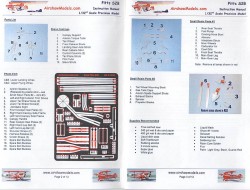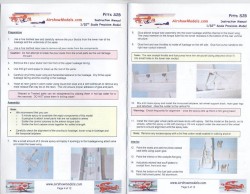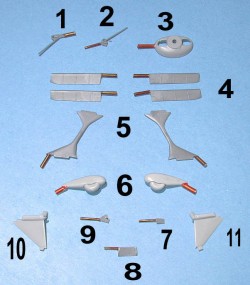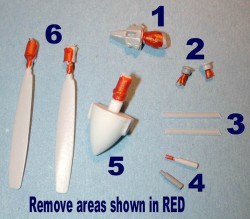Airshow Models 1/32 Pitts S2BBy Brad HagenPhotos by: Barney Dunlevy | 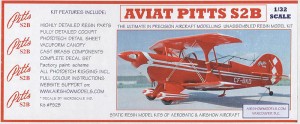 |
History
 The Pitts Special!! This lively little biplane is a legend in aviation winning countless local and national competitions, not to mention the world aerobatic title, but how many know of its humble beginnings.
The Pitts Special!! This lively little biplane is a legend in aviation winning countless local and national competitions, not to mention the world aerobatic title, but how many know of its humble beginnings.
Curtis Pitts was looking for a fun sport plane, but after WWII there wasn't much available except "Cub" type airplanes which left him only one choice - design and build his own. The first Pitts was built in a short amount of time and first flew in 1945 (a replica of the first Pitts was built in the early '90s, here is an article on flying that plane). The first Pitts was powered by a 55 hp Lycoming and proved to be a sprite little performer.
There were around a half-dozen Pitts Specials built in the early years and used in competition and winning them easily and were very popular airshow performers. Most eventually crashed, the whereabouts of one is unknown and the second Pitts built "Little Stinker" flown by Betty Skelton now hangs in the Smithsonian.
 In the 50's the home built movement was gaining popularity and some people remembered the Pitts, plans were drawn up for the "flatwing" and offered for sale in 1960. Originally it had 100 hp, but the horsepower race was soon on as pilots could never have enough, it quickly went to 125 hp, 150 hp, then to 180 hp. "Roundwing" Pitts were offered for the ultimate in aerobatics, they perform just as well upside down as they do right side up and also stall the same whether they are right side up or upside down. Curtis received a patent for his airfoil design.
In the 50's the home built movement was gaining popularity and some people remembered the Pitts, plans were drawn up for the "flatwing" and offered for sale in 1960. Originally it had 100 hp, but the horsepower race was soon on as pilots could never have enough, it quickly went to 125 hp, 150 hp, then to 180 hp. "Roundwing" Pitts were offered for the ultimate in aerobatics, they perform just as well upside down as they do right side up and also stall the same whether they are right side up or upside down. Curtis received a patent for his airfoil design.
Curtis realized there was a need for an aerobatic trainer as no trainers at that time could do all of the maneuvers needed in competition. In the mid '60s he started work on the two hole Pitts, to complicate matters Curtis wanted to get the plane certified by the FAA, that's a place even the manufacturing giants fear to tread. Through a lot of struggling, headaches, and sheer determination the two hole Pitts was finally certified.
While the two hole Pitts looks like a model plane to a lot of pilots (there are radio controlled airplanes with a larger wing span), it looked positively gigantic next to the single hole Pitts. In the S2B the horsepower has jumped up to 260 and special built Pitts for competition and airshow work sport engines over 300 hp. The Pitts design is pushing 60 years of age and has had over a 550% increase in hp and there is no end in sight, truly an amazing airplane!!
The Kit
Being used to large model boxes with the kits we build, I was a little surprised when I received an envelope with Airshow Models return address on it, I could tell there was a box in it but my initial reaction was wondering what it was. In the excitement of receiving the kit so fast, I forgot that the real Pitts is a small airplane (a 7 1/2 inch top wing in 1/32 scale) which makes for a small model box!
The box measures roughly 10 x 6 x 1 1/2 inches, is very sturdy and comes with a full-color label on the cover showing a picture of the finished model and a description of what you will find inside. Upon opening the box you'll find a very well packed kit with the resin pieces, brass pieces, vac parts, photo-etch, and details all in their own labeled ziplock bags, and a 12 page instruction booklet.
All of the resin parts are solid cast and warp free with exquisite detail molded in. I was pleasantly surprised to find there was virtually no flash, only two parts in my kit had flash and a few quick swipes with a sanding stick removed it. The only other cleanup that will need to be done is the cutting off of the small pour stubs which can be seen in photos farther on in the review.
My digital camera software died when I tried to take photos for this review, I scanned in the instruction book, photo etch, and decals, Barney Dunlevy came to the rescue with photos he took of his kit, thanks Barney!!
Instructions
The instruction booklet in this kit is one of the best I have seen in any kit so far, its 12 pages are printed on a heavy paper stock and there are no less than 23 color photos to get you through the construction and a full-color 3 view drawing of a Pitts S2B in the factory paint scheme.
The first page of the instruction book gives you a short history of the real plane and a couple photos of the finished model. The next two pages will tell you everything that is inside the kit, with numbered photos showing all of the small parts and corresponding text so the parts can be easily identified. Barney Dunlevy who built the prototype kit also put together the instructions and as a further aid to make the building easier, he colored the pour stubs red in the photos so there would be no doubt as to what needs to be removed.
You are walked step-by-step through the building process and there are pink warning boxes to let you know of any potential problems to watch out for and yellow boxes with suggestions from his building the kit, both the warning and suggestion boxes will help save some head scratching and possible problems during the building process.
Barney asked me to say in my review that there is a typo on the page with the photo etch description "Item #3 Left and Right Aileron Trim Drive", it should read "Elevator Trim Drive".
 The cowl is solid resin and the engine cylinders are molded on the front, all it will need is some careful painting of the cylinders to highlight the fins as they are not that visible through the openings. The front of the cowl is a separate piece (in a picture below) as it is on the real Pitts and from my dry fitting leaves a fine line which is on the real plane. The panel lines and screw heads (of which there are very few) are finely engraved, no big troughs here!
The cowl is solid resin and the engine cylinders are molded on the front, all it will need is some careful painting of the cylinders to highlight the fins as they are not that visible through the openings. The front of the cowl is a separate piece (in a picture below) as it is on the real Pitts and from my dry fitting leaves a fine line which is on the real plane. The panel lines and screw heads (of which there are very few) are finely engraved, no big troughs here!
The cockpit of the real Pitts is extremely sparse, if something isn't absolutely needed, it isn't there, weight is the mortal enemy of an aerobatic aircraft. This is reflected in the kits cockpit, there just aren't that many parts.
 The internal framework of the Pitts is molded into the cockpit and represents it very well (these two photos are after Barney has done a little work in the cockpit) and stands out nicely with some painting. If you wanted to super detail the cockpit by building your own tube frame, it would be easy to remove the molded in framework and pictures of the framework are readily available on the net.
The internal framework of the Pitts is molded into the cockpit and represents it very well (these two photos are after Barney has done a little work in the cockpit) and stands out nicely with some painting. If you wanted to super detail the cockpit by building your own tube frame, it would be easy to remove the molded in framework and pictures of the framework are readily available on the net.
The seats are one-piece resin units, after the red indicated areas have been removed and the seats painted, they can be slipped in place, they nicely capture the look of the fabric of the real seats.
 Airshow Models Christen Eagle II (review and build article) seats have the seat belts molded in, the seats in the Pitts have been improved by not only not having the seat belts molded in, but by giving you two choices for the seat belts. You can either use the photo etch seat belts or Pete supplied the buckles for both seats and you can use your favorite seat belt material.
Airshow Models Christen Eagle II (review and build article) seats have the seat belts molded in, the seats in the Pitts have been improved by not only not having the seat belts molded in, but by giving you two choices for the seat belts. You can either use the photo etch seat belts or Pete supplied the buckles for both seats and you can use your favorite seat belt material.
Because of the cramped conditions of the Pitts cockpit (the pilot has to put his legs around the front seat to reach the rudder pedals which are lined up with the passengers hips), they are modified to fit the needs of the pilot depending on his height and stature. One item that is very tough to find room for is the radio, most mount it on the back of the passengers seat which is where this kit has it mounted. Some pilots will mount the radio on the right side of the cockpit, the taller pilots find they keep hitting their knee on it. The radio is nicely detailed with little knobs and switches, with the large canopy and lack of items in the cockpit, it will stand out.
 The cockpit top has both the front and rear instrument panels molded in, there are slight recesses for the instrument dials, but you will need to supply your own instruments. The kit represents the factory standard dash, but they do vary in layout to suit the individual pilots needs.
The cockpit top has both the front and rear instrument panels molded in, there are slight recesses for the instrument dials, but you will need to supply your own instruments. The kit represents the factory standard dash, but they do vary in layout to suit the individual pilots needs.
To give the pilot more room, the rear dash of the real Pitts is moved forward about three inches to give the pilot a little more room and this is captured in the models dash. The Pitts only has a few knobs and switches and these are well represented, the toggle switches are the best I have seen in any kit and there is even a key in the ignition!
The Pitts fuel tank is just ahead of the passengers instrument panel and is visible if you look of the cockpit, the fuel tank is molded into the cockpit top as can be seen in the photo.
 The bottom of the fuselage has slots to ensure precise landing gear placement and from dry fitting my parts, they basically snapped in place without a big gap, the same goes for the fitting of the lower wing.
The bottom of the fuselage has slots to ensure precise landing gear placement and from dry fitting my parts, they basically snapped in place without a big gap, the same goes for the fitting of the lower wing.
From my dry fitting, it doesn't look like any putty will be needed, in fact the only place that I have found that may need some putty is where the cockpit top attaches to the fuselage, but that only comes from my initial dry fitting, I'll have to see what it's like after a glue it on. I haven't tried fitting the clear vac under side window yet.
Wings and tail
 The wings and tail have the same delicate fabric detail of the fuselage and the inspection panels in there appropriate places. The wings, tail, and rudder have the pinking tape and rib stitching subtly molded in giving you realistic effect.
The wings and tail have the same delicate fabric detail of the fuselage and the inspection panels in there appropriate places. The wings, tail, and rudder have the pinking tape and rib stitching subtly molded in giving you realistic effect.
As can be seen in the above photo, the wings have slots for the wing struts and for the cabane struts and those parts snap in easily making alignments of the wings easy for a biplane. What is hard to see in the photos are the small recesses for the ends of the photo etch flying wires and the small holes for the aileron slaves struts.
The rudder and ailerons are molded separately and can be positioned however you would like them. The elevator is attached to the stabilizer in a slight down angle and the elevator trim tabs are molded slightly raised.
Small parts
The Eagles prop and spinner were cast in white metal, the Pitts are cast in resin and are crisply molded, after cleaning off the pour stubs, the blades can be glued into recesses in the spinner.
These pictures show the small resin parts, the detail is just as crisp in the small parts as in the large parts. From my dry fitting the landing gear and cowl parts fit together very nicely.
 Brass parts
Brass parts
With the Eagle, Pete found out that the white metal parts weren't up to the quality he insists on so he switched to cast brass parts. He stayed with the brass parts with the Pitts. The cabane struts, landing gear struts, tail wheel, control sticks, etc. are very well molded with no flash and the cabane struts have locating pins to ensure they accurately line up.
Photo etch
 The photo etch sheet is very thin and flexible with fine detail etched in the appropriate parts. The flying wires and tail brace wires are done in photo etch which will greatly simplify rigging your model. Some may think the photo etch is too flat and prefer to use fishing line, stretched sprue, or some other method, neither are completely accurate and until someone comes up with airfoil shaped rigging, the photo etch is a good compromise and the time saved is well worth it.
The photo etch sheet is very thin and flexible with fine detail etched in the appropriate parts. The flying wires and tail brace wires are done in photo etch which will greatly simplify rigging your model. Some may think the photo etch is too flat and prefer to use fishing line, stretched sprue, or some other method, neither are completely accurate and until someone comes up with airfoil shaped rigging, the photo etch is a good compromise and the time saved is well worth it.
As I mentioned above, there are seat belt buckles and seat belts, if you choose to use the buckles and your favorite material, the photo etch seat belts will make good patterns so you can cut the belts to the right length, width, and shape the first time.
Other parts included on the sheet are the canopy rails, the sighting device for the port wing, the "floorboards", the aileron shovels, with the shovels you have the choice of using the photo etch attachments or resin attachments, with resin being the recommended choice.
Clear parts
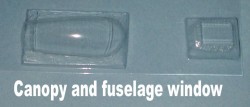 There are two clear parts that come with the kit, the canopy and the window for the bottom of the fuselage. The canopy comes as a one-piece unit and there are photo etch rails to be attached to the inside of the main canopy. The clear vac parts are very well made and crystal clear.
There are two clear parts that come with the kit, the canopy and the window for the bottom of the fuselage. The canopy comes as a one-piece unit and there are photo etch rails to be attached to the inside of the main canopy. The clear vac parts are very well made and crystal clear.
The canopy is very large for such a small model and if you leave the canopy closed to have a dust free cockpit, you will still be able to see the detail inside the cockpit. A second set of clear parts are included in case you make a mistake cutting out your first parts or if you like to display the canopy in the open position.
Decals
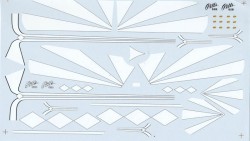 The decals are for a factory standard paint scheme and include the Pitts logo for the fin in both black and the more typically used white with black outline. The decals were printed by Microscale so you know they are quality decals, plus they were double printed to ensure that the red (or any other color you choose to use) won't bleed through. The pinstriping on the starburst and diamonds is extremely fine and the pinstriping on the fuselage and wheel pants stripes go from wide to narrow, all printing was perfectly in register. Propeller logos are also included.
The decals are for a factory standard paint scheme and include the Pitts logo for the fin in both black and the more typically used white with black outline. The decals were printed by Microscale so you know they are quality decals, plus they were double printed to ensure that the red (or any other color you choose to use) won't bleed through. The pinstriping on the starburst and diamonds is extremely fine and the pinstriping on the fuselage and wheel pants stripes go from wide to narrow, all printing was perfectly in register. Propeller logos are also included.
Registration numbers and letters are not included on the decal sheet but are available separately from Airshow Models, I haven't seen them so I am unable to comment on them. The numbers and letters on the real Pitts vary in style, size, and some have pinstriping. You can either use numbering and letter decals from a spare decal sheet, or if you'd like to make your own, Vernon Rabbetts has a good tip "Number and Letter Builder" which will simplify the task.
Conclusion
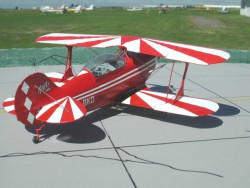 It was a long wait from the time I first heard this kit was going to be produced until it was released and the wait was well worth it. Pete would not released the kit until everything in it met his stringent standards and it shows, everything in this kit is top-quality.
It was a long wait from the time I first heard this kit was going to be produced until it was released and the wait was well worth it. Pete would not released the kit until everything in it met his stringent standards and it shows, everything in this kit is top-quality.
The resin parts in my kit ranged from a very dark gray to a very light gray. I asked Barney if there was a particular reason for this, he talked to Brian Fawcett (who makes the masters for these kits) about it and here is a synopsis of his reply:
"Two types of resin are used in the Pitts, one is tough and has more give and the other is more suited to the thicker parts. The resin is translucent and dye is added to give a better appearance. The Pitts are only one item that uses the resin that is made and only uses a small amount of it, some of the larger jobs want a lighter colored resin and some want darker resin, when the Pitts are cast, they will use whenever dye is already mixed. The resin used for the Pitts was designed for coating undersea telephone cables and with a few changes has proven to be very good for model work."
Now that I have finished this review I have started working on the kit and it is the best resin I have run across so far.
If you're looking for something that is different from what you have been building or are suffering from AMS and are looking for something that can be built easily and quickly right out of the box and look great to boot, you don't have to look any farther than this kit. With its bright and shiny paint job and small size, it will really stand out amongst the military planes on your shelf and on the contest table!!
As the saying goes...

